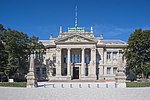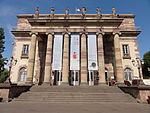22, Rue du Général de Castelnau

The House on 22, Rue du Général de Castelnau is an Art Nouveau building in the Neustadt district of Strasbourg, France. It is classified as a Monument historique by the French Ministry of Culture since 1975. Located at the angle of Rue du Général de Castelnau and Rue du Maréchal Foch, it has a triangular plan and two facades. The house was built from 1901 until 1903 by the architects Franz Lütke (1860–1929) and Heinrich Backes (1866–1931), who used one of the floors as their office. Lütke and Backes were professional partners from 1898 until 1907. A very prolific duo, they built a number of other Art Nouveau houses in Strasbourg, of which several are classified as Monuments historiques as well (such as 46, Avenue des Vosges; 56, Allée de la Robertsau; 4, Rue Erckmann-Chatrian; and 24, Rue Twinger).In spite of the use of reinforced concrete, the house is described as "lithe and light" (souple et léger). It has been called "probably the finest Art Nouveau apartment building in the city".
Excerpt from the Wikipedia article 22, Rue du Général de Castelnau (License: CC BY-SA 3.0, Authors, Images).22, Rue du Général de Castelnau
Rue du Maréchal Foch, Strasbourg Centre
Geographical coordinates (GPS) Address Nearby Places Show on map
Geographical coordinates (GPS)
| Latitude | Longitude |
|---|---|
| N 48.589027777778 ° | E 7.7511111111111 ° |
Address
Rue du Maréchal Foch 31
67073 Strasbourg, Centre
Grand Est, France
Open on Google Maps











